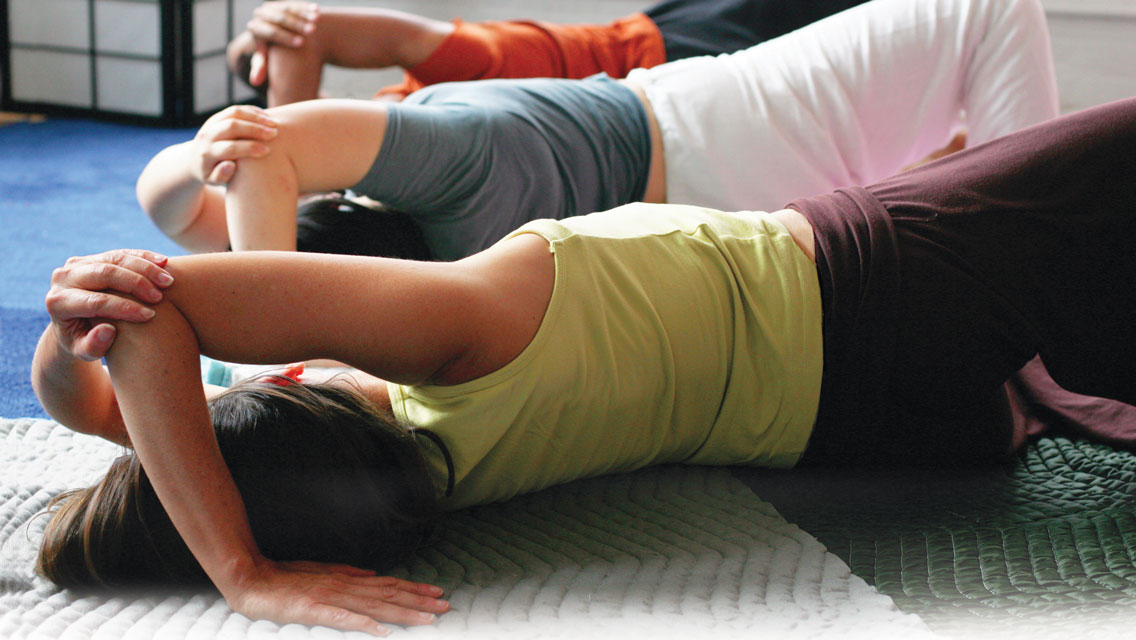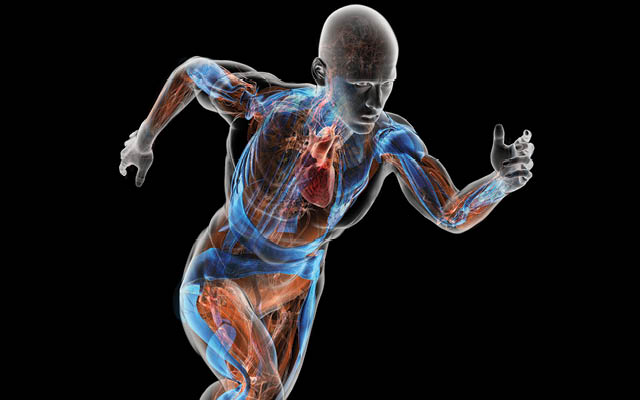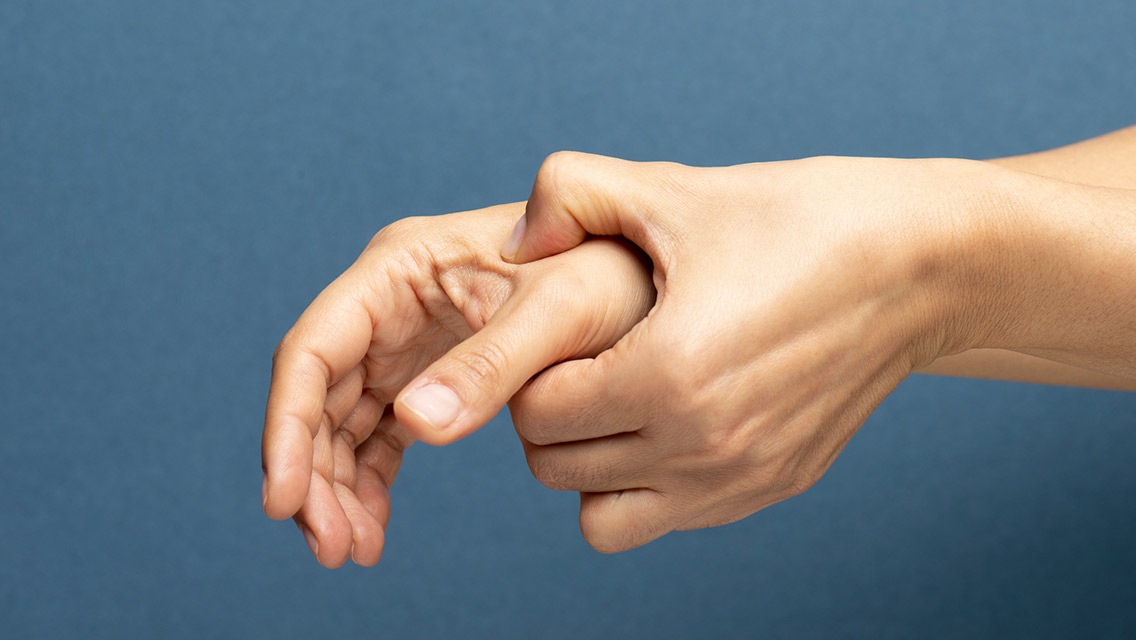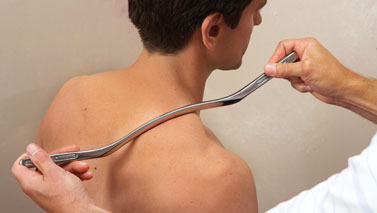Jump down to:
A Feldenkrais-Inspired Test for Instant Rotational Improvement
In 1999, John Dumas, a 52-year-old writer and karate enthusiast from Los Angeles, sat in a doctor’s office and heard four words no active person ever wants to hear: “You’ve blown your ACL.”
The scalpel-shy Dumas wanted to avoid surgery, so the doctor referred him to Stacy Barrows, PT, GCFT, CPI, a physical therapist, Pilates instructor and practitioner of the Feldenkrais Method, a gentle, simple system of teaching and reinforcing healthy, efficient movement patterns. After working with Dumas for three months, Barrows cleared him to return to karate.
A few years later, Dumas found himself in the hospital with an injury to his opposite knee. For comparison’s sake, the doctor performed a “drawer” test — which checks the integrity of the ACL — on Dumas’s previously rehabbed knee. “See, this is how a healthy knee should respond to this test,” the doctor told him, unaware of the prior injury. “There’s no give in your ACL.”
“But I don’t have an ACL on that knee,” Dumas protested.
Skeptical, the doctor repeated the test and got the same result. Only when he saw Dumas’s prior injury on an MRI was he willing to believe that the knee — which seemed to function perfectly — was missing its ACL.
Dumas’s ligament hadn’t magically regrown. Rather, through a combination of physical therapy and Feldenkrais lessons, his body had relearned how to move. His remaining muscles and ligaments were taking up the slack for the missing ACL so effectively that he fooled the doctor’s test. Twice.
What Is Feldenkrais Exactly?
Moshé Feldenkrais was a Ukrainian-born physicist and mechanical and electrical engineer who initially devised his system to rehabilitate a recurring knee injury aggravated by years spent practicing judo and playing soccer. Over time, he found that certain precise, effortless movements performed with focus and awareness could have profound effects on healing, on movement efficiency and on health in general.
Feldenkrais is considered a form of somatic education, or a way of learning through and with the body, rather than a passive form of treatment. “The primary focus in Feldenkrais is the brain and its capacity to learn,” says Staffan Elgelid, PhD, PT, GCFT, who practices in Pittsford, N.Y. “You’re constantly learning about your habits and finding other options.”
Feldenkrais movement has been shown to enhance the plasticity of the neuromuscular system, forging new neural pathways throughout the brain, spinal column and muscles. Essentially, the brain and body learn to communicate better, resulting in smoother, more coordinated movements, better posture and, oftentimes, a greater sense of well-being.
“It’s like doing crossword puzzles for the body,” says Barrows, the Los Angeles practitioner who treated Dumas. Just as working the Sunday crossword increases your language fluency by exposing you to new words and subtle shadings of meaning, Barrows suggests, doing Feldenkrais improves your physical functioning and athleticism by introducing the body to nuanced ways of moving.
How Feldenkrais Builds Better Body Awareness
We may think we’re experts in moving our own bodies, but physical awareness and learning are noticeably absent in most adult lives: After a childhood spent running, jumping, climbing and exploring, most of us spend the majority of our time engaged in habitual, repetitive movements and rigid postures. We stand, walk, sit at computers. Even diligent exercisers — such as runners, cyclists and swimmers — often repeat the same physical patterns for many hours in a single week.
Feldenkrais practitioners believe that if you do this long enough, your body stops learning. Your swimming stroke, golf swing and bench press no longer improve. Everyday activities like walking, sitting or chopping vegetables become unconscious and habitual. Your body begins to resemble a piano player with a limited repertoire, always pulling out the same old standards.
Previous injuries can compound the problem. “When you get injured, you limit movement to stop the pain. Once the pain is gone, though, you don’t start to move as if you were never injured — the brain still remembers the injury and protects the area,” says Elgelid. Such compensation can lead to further problems. “Unless you retrain those movement abilities, you limit yourself more and more.”
How Feldenkrais Can Improve Athletic Performance
Feldenkrais is not meant to be a substitute for conventional medicine or physical therapy, which remain the preferred avenues for treating the acute stages of injury. But once severe symptoms have subsided, a Feldenkrais practitioner can supply the missing link between the initial healing stages of an injury and normal (or even improved) function and performance.
The applications of Feldenkrais go beyond pain management. Top athletes will often consult a Feldenkrais practitioner when they’ve hit a wall in their training. “Many athletes plateau after five or 10 years in their sport,” says Elgelid. “They’ve taken their individual movement patterns as far as they can. But Feldenkrais work can subtly tweak those patterns and make you even more efficient.”
Movement efficiency is often what separates elite athletes from their competition. They perform their sport with maximum control and efficiency every time: The right muscles fire with the right amount of effort in the right sequence; simultaneously, other muscles lengthen and relax with equal precision.
Elite athletes are usually born with a natural aptitude for streamlined movement, but, according to Barrows, Feldenkrais “brings movement mastery to the masses.”
Subtle Approach to Pain Relief and Improved Functionality
Unlike standard-issue gym workouts, Feldenkrais lessons almost never involve sweating, straining or pain. Many of the movements are almost imperceptible; some even involve no movement at all, requiring that a client only visualize moving. And, because these movements are unfamiliar and hard to describe, Feldenkrais is best done under a practitioner’s supervision.
A session usually consists of both a hands-on and a hands-off component: Functional Integration (FI) resembles a gentle but highly specialized massage, with the instructor manipulating the client’s body on a padded table. In Awareness Through Movement (ATM), the practitioner leads the client through a series of movements done while lying, sitting or standing. FI is typically done one-on-one; ATM is presented both privately and in classes.
During table work, the practitioner may stay clear of the injured area itself. But the pain at the site of injury will often subside significantly, regardless. “The brain doesn’t understand the concept of isolation,” says Barrows. “The brain understands movements, not muscles. Whatever you do to one part of the body affects the system as a whole.” Studies have shown that when a person just thinks about lifting his arms, for example, the muscles at the front of the shins turn off in preparation for the weight shift. This is as true for bodywork as it is for exercise.
In ATM, clients perform movement “puzzles” applicable to their specific problem or goal. A client with an ankle problem, for example, may lie prone on a mat with a book balanced on the sole of his elevated foot. He then attempts to circle his lower leg while keeping the book level, like a waiter holding a tray of drinks. This is done while attending to small movements in the other parts of the body. Upon standing, his foot and ankle will have greater sensitivity to the floor, to weight and directional shifts, and to movement in general.
Results vary based on the duration and severity of the injury, and on the client’s willingness and ability to learn, practitioners say. But most people will see marked improvement in pain and functioning after two or three sessions, and many will sense an easing of their symptoms right away.
As for clients seeking improved athleticism, results are immediate. “I don’t think anything improves athletic performance as quickly or effectively as Feldenkrais,” says Elgelid. A long-distance runner himself, he’s careful to add that Feldenkrais isn’t a substitute for a good training plan, which will likely be grueling, regardless: “If you want to run a marathon in 2:10, it’s going to hurt; I don’t care how much Feldenkrais you do.”
Exceptional Results
Is it possible, though, that at least some of the time we’ve spent grunting and sweating to get better, stronger and faster would have been better spent doing nothing more than attending to subtle, often very relaxing movements?
Arton Baleci, 24, a recent university graduate from Stockton-on-Tees, England, is a believer. Last September, the self-confessed “below-average” athlete embarked on an odyssey to transform himself into an elite-level soccer player with the help of a team of experts (a journey he chronicles at www.thebeautifulaim.com). Included in his handpicked team of coaches, nutritionists, sports-vision experts and therapists are two Feldenkrais practitioners.
“I wouldn’t have started this project without Feldenkrais,” he says. “I was having serious knee pain when I began. A practitioner cleared that up in two sessions. Since then I’ve had a session about every three weeks to help both with injury recovery and performance enhancement, and it’s gone very well.”
Very well, indeed: After just six months, his results on most speed and agility tests fell into the midrange among pro footballers; now he’s shooting for the upper echelons.
A Feldenkrais-Inspired Test for Instant Rotational Improvement
Not quite ready to believe that gentle, easy movements can really make a difference in your body? Try this test, adapted from a Feldenkrais Method Awareness Through Movement lesson. It improves most people’s rotational flexibility by 10 percent (or more) in about one minute.
- Stand relaxed, feet parallel at hip width, arms hanging naturally at your sides.
- Lift your right arm directly out to your side, thumb up.
- Keeping your arm straight and your hand at shoulder height, reach your right arm as far behind you as you can by rotating your torso. Be sure your hips face forward the whole time. Using a spot on the wall behind you as a reference point, note how far back you were able to reach your hand. Return to a neutral stance.
- Standing relaxed again, perform a series of five to 10 slow hip circles (think hula-hoop motion) in both directions. Keep circles slow and easy. Don’t stretch! Simply feel the hips gently rotating.
- Repeat the test.
- From a neutral stance, now perform a series of five to 10 easy turns of the head, first looking right, then left. Again, don’t stretch the neck muscles or strain in either direction; simply bring your awareness to the action of the neck and head as it rotates on top of your spine.
- Repeat the test.
- Finally, keeping your posture erect and your head still, now turn your eyes as far to the right as you can, then as far to the left as you can. Move your eyes back and forth five to 10 times.
- Repeat the test, noting the difference in reach from the first test.
(For more on this healing modality, see “What Is Feldenkrais?“)
This article originally appeared as “The Feldenkrais Fix.”





This Post Has 0 Comments